The Concept of Demonstrating Non-Existent Architecture Using Light Projection
Abstract
1. Introduction
1.1. Illusory Reconstruction In Situ as Information About Unpreserved Architectural Objects
1.2. Light as a Means of Enriching Architectural Space
1.3. The Use of Light for Illusory Reconstruction
2. Plan and Characteristics of This Research
- A drawing mapped on surfaces constituting the viewports of the projection;
- A drawing displayed on these surfaces.
3. Description of This Research
3.1. Experimental Research
3.2. Simulation of the Light Projection in an Authentic Public Space—“The Masonry Gate” in Rzeszów
3.2.1. The History of the Building and the Place
3.2.2. Light Projection Constraints and Design
4. Results
5. Discussion
6. Conclusions
Author Contributions
Funding
Data Availability Statement
Acknowledgments
Conflicts of Interest
| 1 | https://www.efeel.pl/projektor-gobo-100w-led-do-70m-projekcji-logo-na-scianach-budynku-wodoodporny (accessed on 27 April 2024). |
| 2 | See note 1 above. |
| 3 | https://norcostco.com/straight-royal-flush-clubs-apollo-glass-gobo-sr-0208/ (accessed on 27 April 2024). |
References
- Acuña, Paula C., S. Leyre, J. Audenaert, Y. Meuret, G. Deconinck, and P. Hanselaer. 2015. Impact of Geometrical and Optical Parameters on the Performance of a Cylindrical Remote Phosphor LED. IEEE Photonics Journal 7: 1601014. [Google Scholar] [CrossRef]
- Araújo, Antonio B. 2020. Anamorphosis Reformed: From Optical Illusions to Immersive Perspectives. In Handbook of the Mathematics of the Arts and Sciences. Edited by Bharath Sriraman. Cham: Springer, pp. 1–68. [Google Scholar] [CrossRef]
- Artemyeva, Tatyana, and Ekaterina Balzannikova. 2020. Application of metareconstruction method as a means of marking traces of lost historical buildings. In IOP Conference Series: Materials Science and Engineering. Bristol: IOP Publishing, vol. 775, p. 012005. [Google Scholar] [CrossRef]
- Baran, Krzysztof, Marcin Leśko, Henryk Wachta, and Antoni Różowicz. 2019. Thermal Modeling and Simulation of High Power LED Module. In Computational Technologies in Engineering (TKI’2018): Proceedings of the 15th Conference on Computational Technologies in Engineering, Jora Wielka, Poland, 16–19 October 2018. Melville: AIP Publishing, vol. 2078. [Google Scholar] [CrossRef]
- Barfuss, Meike, Alexander Rosemann, Dirk Seifert, and Werner Osterhaus. 2024. Lighting Technology. Fundamentals of Illuminating Engineering. Cham: Springer. [Google Scholar] [CrossRef]
- Bartolomei, Cristiana, Alfonso Ippolito, Cecilia Mazzoli, and Caterina Morganti. 2020. From anamorphosis to vision: “3D Sidewalk Chalk Art”. Disegnarecon 13. [Google Scholar] [CrossRef]
- Boboc, Răzvan Gabriel, Mihai Duguleană, Gheorghe-Daniel Voinea, Cristian-Cezar Postelnicu, Dorin-Mircea Popovici, and Marcello Carrozzino. 2019. Mobile Augmented Reality for Cultural Heritage: Following the Footsteps of Ovid among Different Locations in Europe. Sustainability 11: 1167. [Google Scholar] [CrossRef]
- Bogdanowski, Janusz. 1974. Okopy miejskie Rzeszowa i problemy ich konserwacji. In Rzeszowska Teka Konserwatorska. Edited by Barbara Tondos. Rzeszów: Muzeum Okręgowe/Biuro Dokumentacji Zabytków w Rzeszowie. [Google Scholar]
- Bojda, Paulina, Lúbomir Beňa, and Henryk Wachta. 2015. Create architectural illumination, taking into account the influence of road lighting. Advances in IT and Electrical Engineering 23: 13–22. [Google Scholar] [CrossRef]
- Borowiejska-Birkenmajerowa, Maria. 1994. Rozwój przestrzenny miasta za Mikołaja Spytka Ligęzy. In Dzieje Rzeszowa Tom I. Edited by Feliks Kiryk. Rzeszów: Krajowa Agencja Wydawnicza. [Google Scholar]
- Čučaković, Aleksandar, and Marijana Paunović. 2016. Perspective in Stage Design: An Application of Principles of Anamorphosis in Spatial Visualisation. Nexus Network Journal 18: 743–58. [Google Scholar] [CrossRef]
- Del Sole, Francesco. 2021. The Architectural Illusion of Edoardo Tresoldi: The Reconstruction of the Basilica of Siponto. Athens Journal of Architecture 7: 257–74. [Google Scholar] [CrossRef]
- di Paola, Francesco, Pietro Pedone, Laura Inzerillo, and Cettina Santagati. 2015. Anamorphic Projection: Analogical/Digital Algorithms. Nexus Network Journal 17: 253–85. [Google Scholar] [CrossRef]
- Drewniak, Konrad, Mirosław Mazurek, and Anna Okoniewska. 2021. Sprawozdanie z Badań Wykopaliskowych na Ulicy Grunwaldzkiej w Rzeszowie—Stanowisko Nr 17. Rzeszów: Fundacja Rzeszowskiego Ośrodka Archeologicznego. [Google Scholar]
- Empler, Tommaso. 2017. Anamorphosis and Contemporaneity. The Design Journal 20: 2858–72. [Google Scholar] [CrossRef]
- Hansford, Dianne, and Dan Collins. 2007. Anamorphic 3D Geometry. Computing 79: 211–23. [Google Scholar] [CrossRef]
- Kohlsted, Kurt. 2020. Remaking History: Transparent “Plaque” Helps People See into the Distant Past. Available online: https://99percentinvisible.org/article/remaking-history-transparent-plaque-helps-people-see-into-the-distant-past/ (accessed on 21 May 2024).
- Koszewski, Krzysztof, Jakub Franczuk, and Karol Argasiński. 2021. Architectural Heritage Virtual Models in Conservation Practice. Journal of Heritage Conservation 68S: 17–25. [Google Scholar] [CrossRef]
- Kotula, Franciszek. 1958. Obwarowanie Rzeszowa i rozwój przestrzenny miasta w XVII i XVIII wieku. In Pięć wieków miasta Rzeszowa XIV-XVIII. Edited by Franciszek Błoński. Warszawa: Państwowe Wydawnictwo Naukowe. [Google Scholar]
- Krupiński, Rafał. 2021. Simulation and Analysis of Floodlighting Based on 3D Computer Graphics. Energies 14: 1042. [Google Scholar] [CrossRef]
- Krupiński, Rafał, Henryk Wachta, Wojciech M. Stabryła, and Cedric Büchner. 2021. Selected Issues on Material Properties of Objects in Computer Simulations of Floodlighting. Energies 14: 5448. [Google Scholar] [CrossRef]
- Lasance, Clemens, and Andras Poppe, eds. 2014. Thermal Management for LED Applications. New York: Springer Science. [Google Scholar]
- Li, Lanxin, and Yue Tang. 2024. Towards the Contemporary Conservation of Cultural Heritages: An Overview of Their Conservation History. Heritage 7: 175–92. [Google Scholar] [CrossRef]
- Liang, Wen, Yahaya Ahmad, and Hazrina Haja Bava Mohidin. 2023. The development of the concept of architectural heritage conservation and its inspiration. Built Heritage 7: 21. [Google Scholar] [CrossRef]
- Lubelczyk, Antoni. 1998. Sprawozdanie z nadzoru archeologicznego prowadzonego nad pracami ziemnymi, związanymi z modernizacją sieci energetycznej w Rzeszowie w 1998 r. Manuscript in: District Museum in Rzeszów. [Google Scholar]
- Mansour, Hasan Mahmoud, Fernando Brandão Alves, and António Ricardo da Costa. 2023. A Comprehensive Methodological Approach for the Assessment of Urban Identity. Sustainability 15: 13350. [Google Scholar] [CrossRef]
- Markowski, Mateusz. 2022. Kładka nad ulicą Chłodną—Najważniejszy Symbol Warszawskiego Getta. Available online: https://www.whitemad.pl/kladka-nad-ulica-chlodna-najwazniejszy-symbol-warszawskiego-getta/ (accessed on 23 May 2024).
- Numan, Nels, Ziwen Lu, Benjamin Congdon, Daniele Giunchi, Alexandros Rotsidis, Andreas Lernis, Kyriakos Larmos, Tereza Kourra, Panayiotis Charalambous, Yiorgos Chrysanthou, and et al. 2023. Towards Outdoor Collaborative Mixed Reality: Lessons Learnt from a Prototype System. Paper presented at 2023 IEEE Conference on Virtual Reality and 3D User Interfaces Abstracts and Workshops (VRW), Shanghai, China, March 25–29; pp. 113–18. [Google Scholar] [CrossRef]
- Panhale, Tanvi, Derek Bryce, and Eleni Tsougkou. 2023. Augmented reality and experience co-creation in heritage settings. Journal of Marketing Management 39: 470–97. [Google Scholar] [CrossRef]
- Panou, Chris, Leonia Ragia, Despoina Dimelli, and Katerina Mania. 2018. An Architecture for Mobile Outdoors Augmented Reality for Cultural Heritage. International Journal of Geo-Information 7: 463. [Google Scholar] [CrossRef]
- Piekarski, Maciej. 2023. Topography of the 18th-century Rzeszów and its relics in the contemporary architectural and urban space of the city. Architectus 73: 17–29. [Google Scholar] [CrossRef]
- Piekarski, Maciej, Ewa Kulpińska, and Anna Prokop. 2021. Illusory Restitution of Not Preserved Architectural Objects—An Analysis of Methods and a Case Study. Space & Form 47: 83–104. [Google Scholar] [CrossRef]
- Pottmann, Helmut, Andreas Asperl, Michael Hofer, and Axel Kilian. 2007. Architectural Geometry. Exton: Bentley Institute Press. [Google Scholar]
- Quattrini, Ramona, Roberto Pierdicca, Emanuele Frontoni, and Roberta Barcaglioni. 2016. Virtual Reconstruction of Lost Architectures: From the TLS Survey to AR Visualization. ISPRS International Archives of the Photogrammetry. Remote Sensing and Spatial Information Sciences 41: 383–90. [Google Scholar] [CrossRef]
- Ramtohul, Arvind, and Kavi Kumar Khedo. 2024. Augmented reality systems in the cultural heritage domains: A systematic review. Digital Applications in Archeology and Cultural Heritage 32: e00317. [Google Scholar] [CrossRef]
- Rewers, Ewa. 2005. Post-Polis: Wstęp do Filozofii Ponowoczesnego Miasta. Kraków: Universitas. [Google Scholar]
- Różowicz, Antoni, Henryk Wachta, Krzysztof Baran, Marcin Leśko, and Sebastian Różowicz. 2022. Arrangement of LEDs and Their Impact on Thermal Operating Conditions in High-Power Luminaires. Energies 15: 8142. [Google Scholar] [CrossRef]
- Russo, Michele. 2021. AR in the Architecture Domain: State of the Art. Applied Sciences 11: 6800. [Google Scholar] [CrossRef]
- Schielke, Thomas. 2019. The language of lighting: Applying semiotics in the evaluation of lighting design. Leukos. 15: 227–48. [Google Scholar] [CrossRef]
- Taher Tolou Del, Mohammad Sadegh, Bahram Saleh Sedghpour, and Sina Kamali Tabrizi. 2020. The semantic conservation of architectural heritage: The missing values. Heritage Science 8: 70. [Google Scholar] [CrossRef]
- Wachta, Henryk, Krzysztof Baran, and Marcin Leśko. 2019. The Meaning of Qualitative Reflective Features of the Facade in the Design of Illumination of Architectural Objects. AIP Conference Proceedings 2078: 020102. [Google Scholar] [CrossRef]
- Ward, Simon. 2016. Urban Memory and Visual Culture in Berlin. Amsterdam: Amsterdam University Press. [Google Scholar]
- Wiedemann, K. H. 1762. Perspective View of Rzeszów Made by K.H. Wiedemann in 1762 (source: District Museum in Rzeszów, sign. MRH 2557). [Google Scholar]
- Wzorek, Zygmunt. 1986. Rzeszów w wieku osiemnastym. Teka Komisji Urbanistyki i Architektury 20: 147–48. [Google Scholar]
- Yoshida, Shogo, Haoran Xie, and Kazunori Miyata. 2021. A wearable augmented reality system with anamorphosis projection. Paper presented at International Workshop on Advanced Imaging Technology (IWAIT) 2021, Online, January 5–6, vol. 11766, pp. 514–19. [Google Scholar] [CrossRef]
- Zhang, Jingru, Wan Ahmad Jaafar Wan Yahaya, and Mageswaran Sanmugam. 2024. The impact of Immersive Technologies on Cultural Heritage: A Bibliometric Study of VR, AR and MR Applications. Sustainability 16: 6446. [Google Scholar] [CrossRef]
- Żagan, Wojciech. 2003. Iluminacja Obiektów. Warszawa: Oficyna Wydawnicza Politechniki Warszawskiej. [Google Scholar]
- Żagan, Wojciech, and Rafał Krupiński. 2016. Teoria i Praktyka Iluminacji Obiektów. Warszawa: Oficyna Wydawnicza Politechniki Warszawskiej. [Google Scholar]

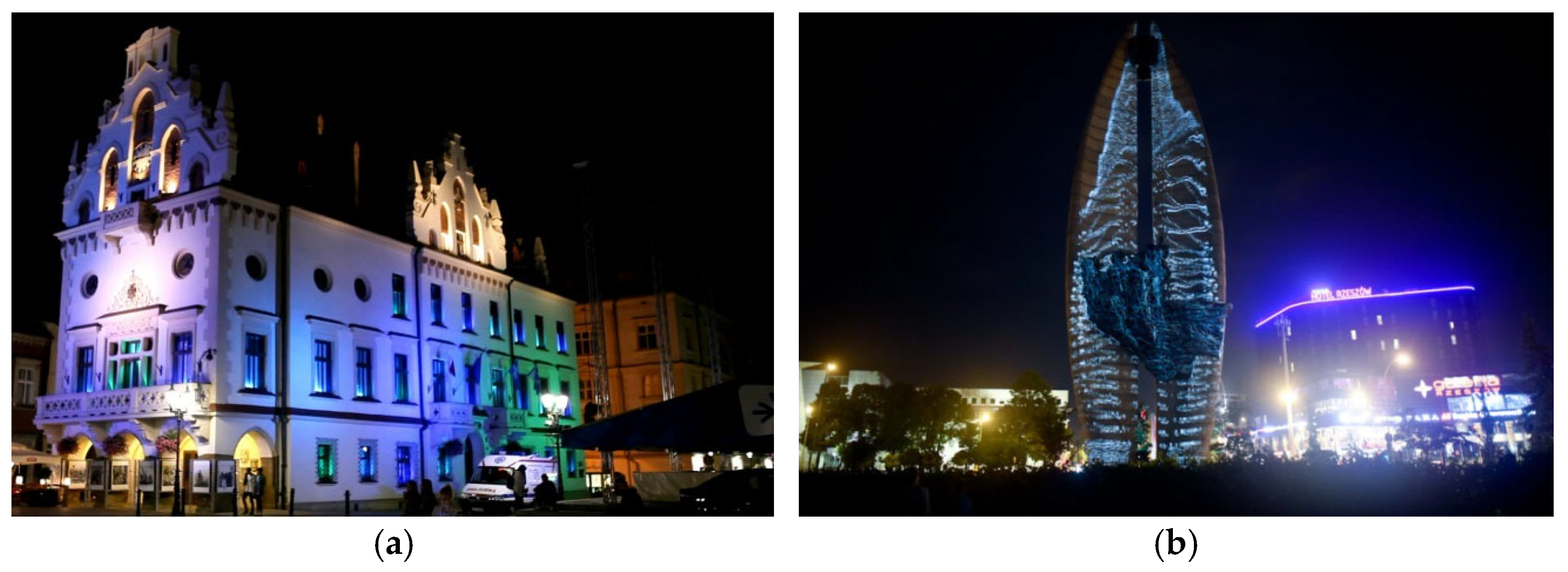

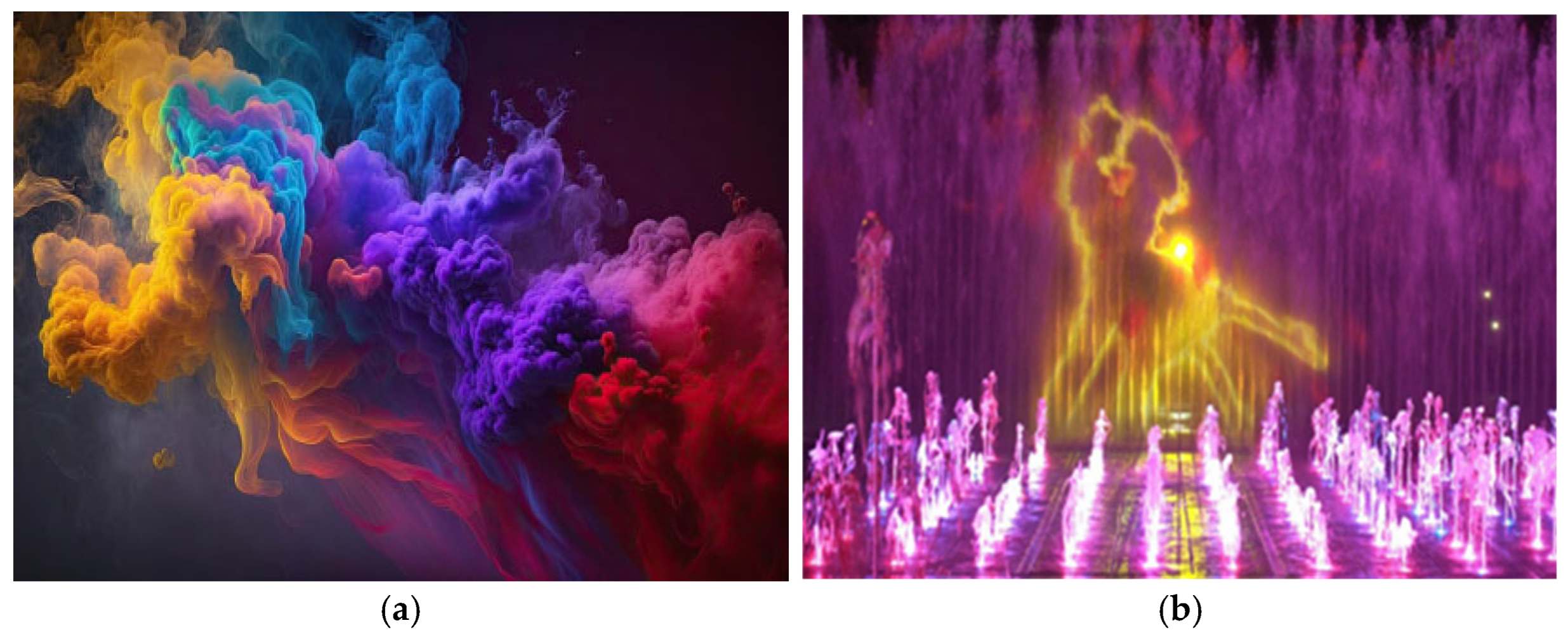
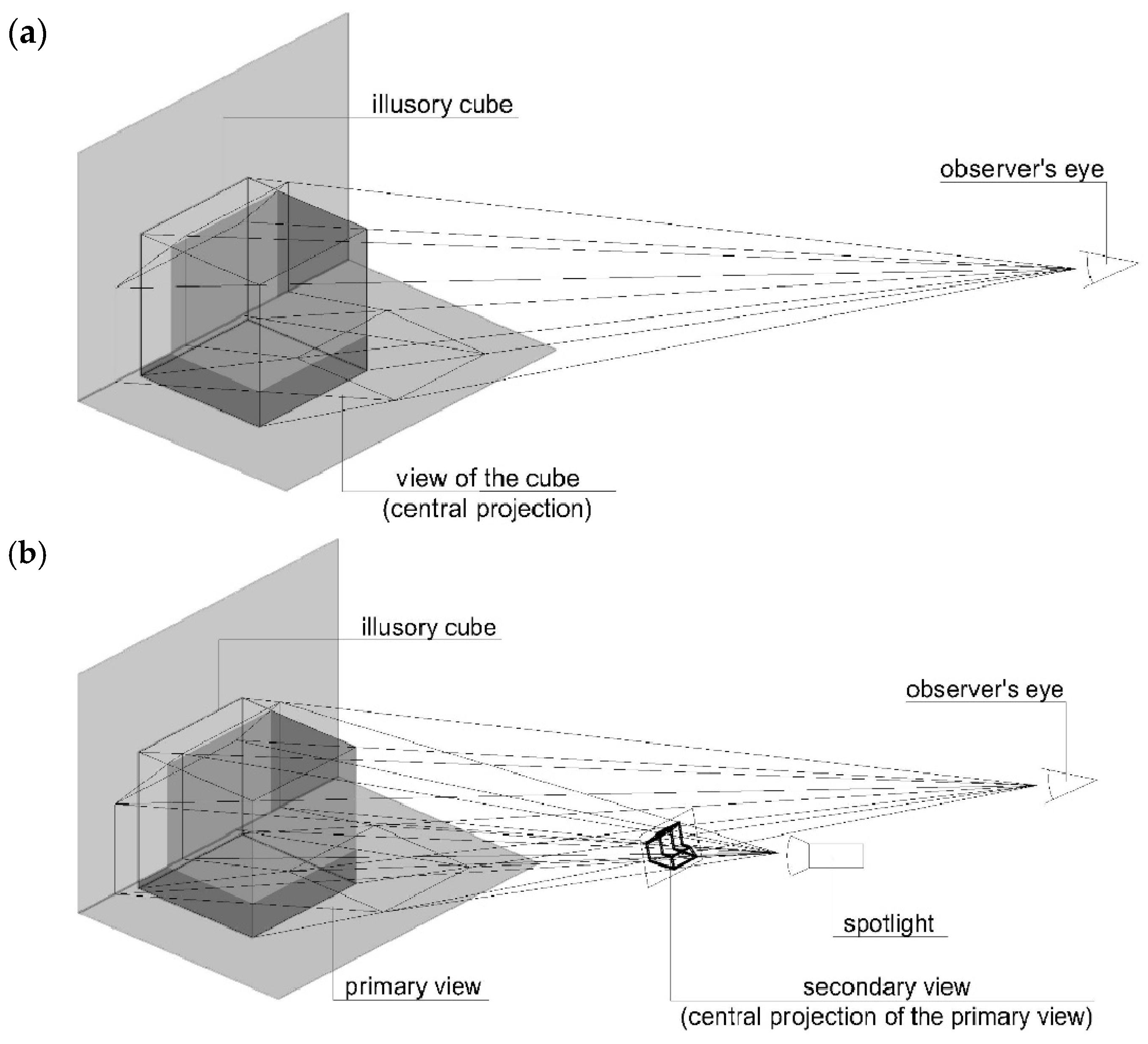




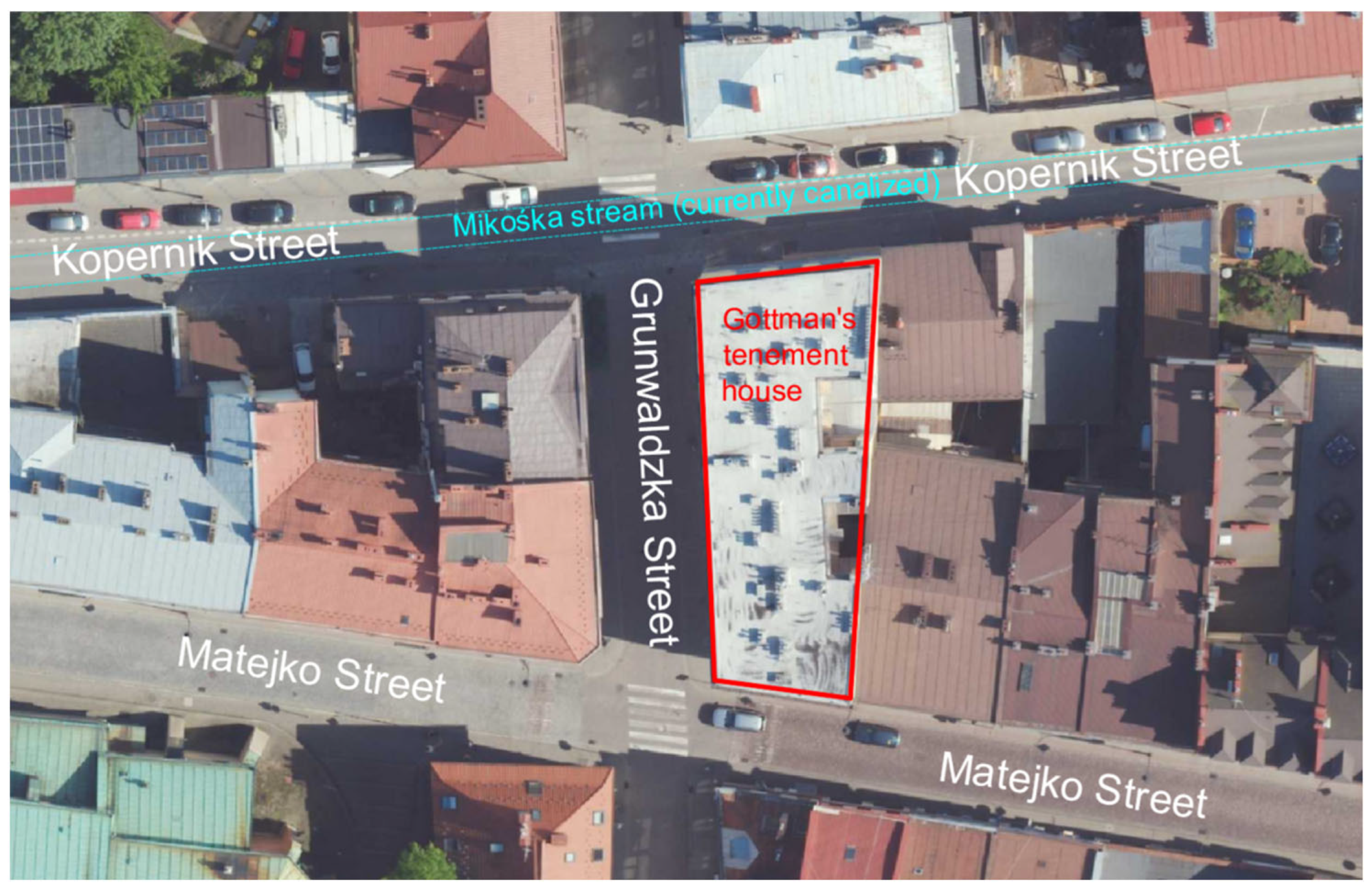

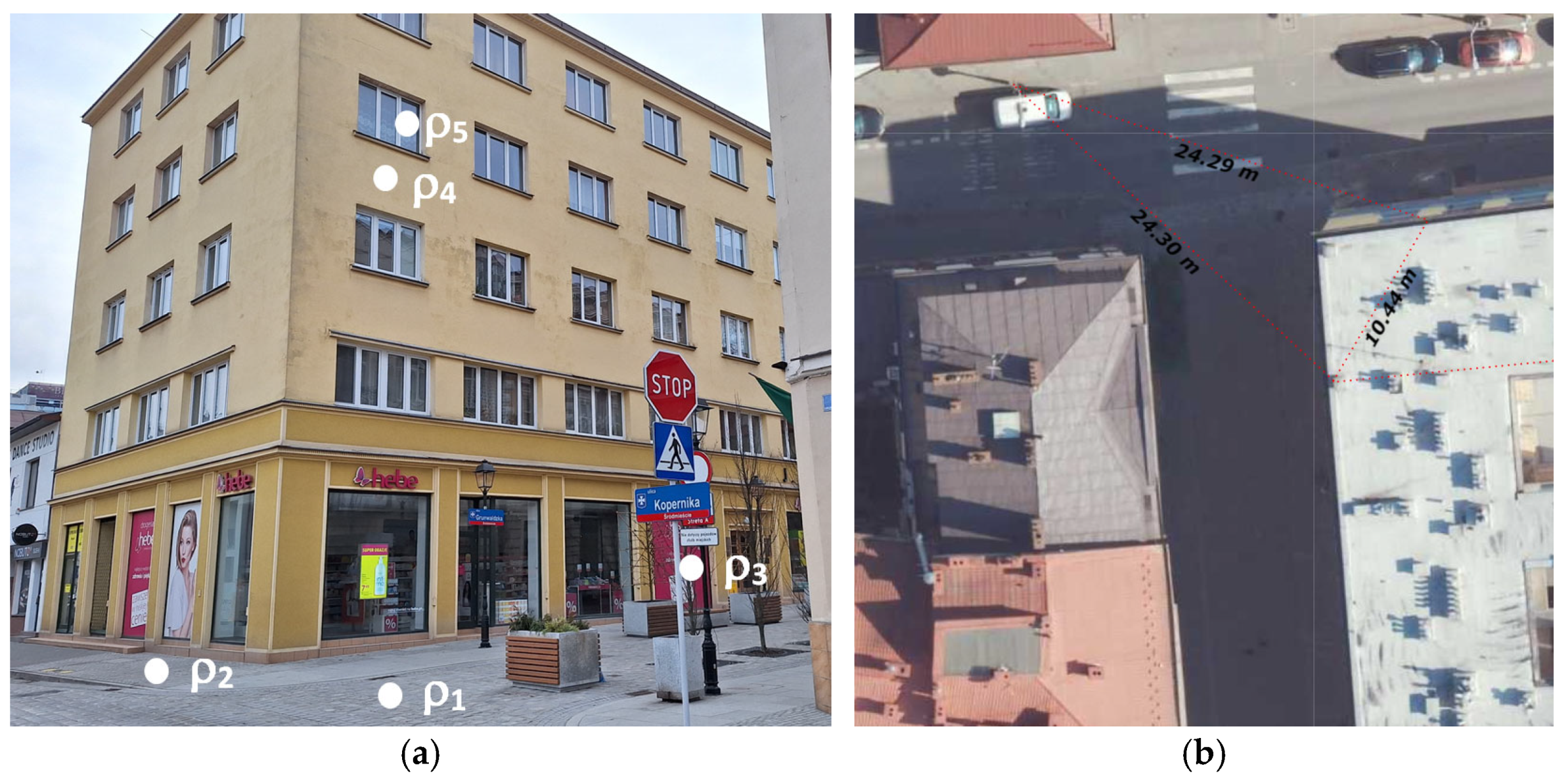

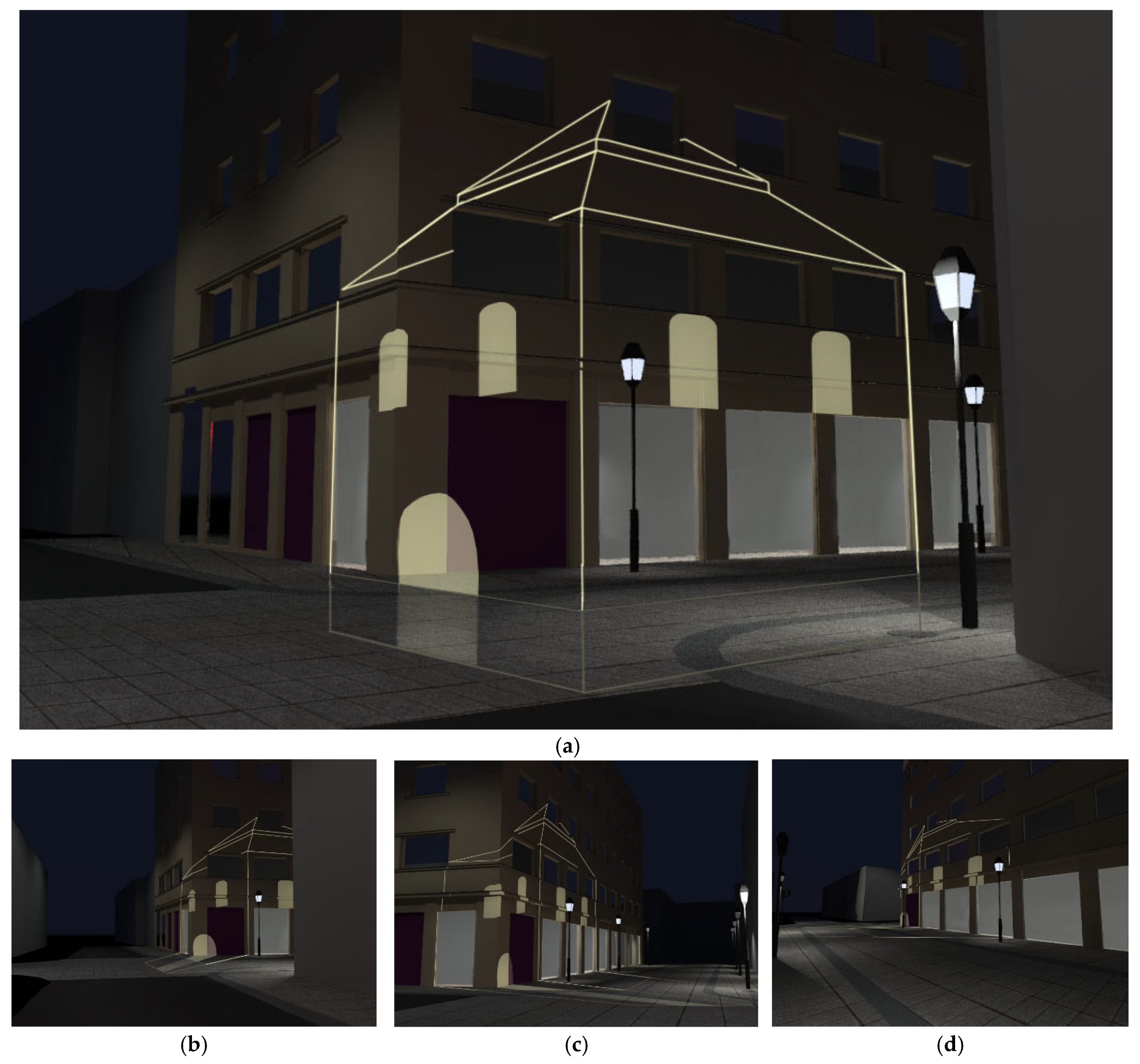
Disclaimer/Publisher’s Note: The statements, opinions and data contained in all publications are solely those of the individual author(s) and contributor(s) and not of MDPI and/or the editor(s). MDPI and/or the editor(s) disclaim responsibility for any injury to people or property resulting from any ideas, methods, instructions or products referred to in the content. |
© 2025 by the authors. Licensee MDPI, Basel, Switzerland. This article is an open access article distributed under the terms and conditions of the Creative Commons Attribution (CC BY) license (https://creativecommons.org/licenses/by/4.0/).
Share and Cite
Piekarski, M.; Kulpińska, E.; Baran, K.; Wachta, H. The Concept of Demonstrating Non-Existent Architecture Using Light Projection. Arts 2025, 14, 35. https://doi.org/10.3390/arts14020035
Piekarski M, Kulpińska E, Baran K, Wachta H. The Concept of Demonstrating Non-Existent Architecture Using Light Projection. Arts. 2025; 14(2):35. https://doi.org/10.3390/arts14020035
Chicago/Turabian StylePiekarski, Maciej, Ewa Kulpińska, Krzysztof Baran, and Henryk Wachta. 2025. "The Concept of Demonstrating Non-Existent Architecture Using Light Projection" Arts 14, no. 2: 35. https://doi.org/10.3390/arts14020035
APA StylePiekarski, M., Kulpińska, E., Baran, K., & Wachta, H. (2025). The Concept of Demonstrating Non-Existent Architecture Using Light Projection. Arts, 14(2), 35. https://doi.org/10.3390/arts14020035






